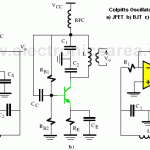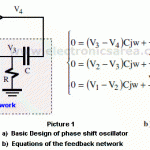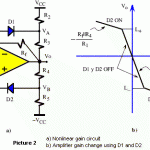The Crystal Oscillators (Piezoelectric Oscillator) A quartz crystal has a property called: piezoelectric effect. This effect causes, by applying a mechanical pressure on the surface of the crystal, that a voltage is developed on the opposite sides. Similarly, a voltage applied on the faces of the crystal produces a mechanical distortion on their surface. An AC voltage causes mechanical vibration whose […]
LC Oscillator – Inductance – Capacitance Oscillator
LC oscillator: Inductance – Capacitance Oscillator A simple oscillator can be built with an amplifier stage and an inductive-capacitive network (LC) to provide an offset of -180°. The oscillation frequency can be freely adjusted or tuned on a range of frequencies from 100kHz to a few hundred MHz by changing only the value of C or L. These LC […]
Phase Shift Oscillator
The phase shift oscillator is a negative gain amplifier (-K) and a feedback network consisting of a third order RC section in cascade
Wien-bridge Oscillator with Op Amp
The Wien-bridge oscillator, consists of an Operational Amplifier (OA) in a non-inverting configuration with gain 1+R2/R1 and a RC feedback network
Nonlinear Amplitude Control of a Sinusoidal Oscillator
Control of a sinusoidal oscillator is done in 2 phases: a linear method based in the frequency domain and a non-linear method using non linear mechanisms
Sinusoidal oscillators – Basic principles
Sinusoidal oscillators play an important role in electronic systems that use harmonic signals. Despite that, in many instances are known as linear oscillators






